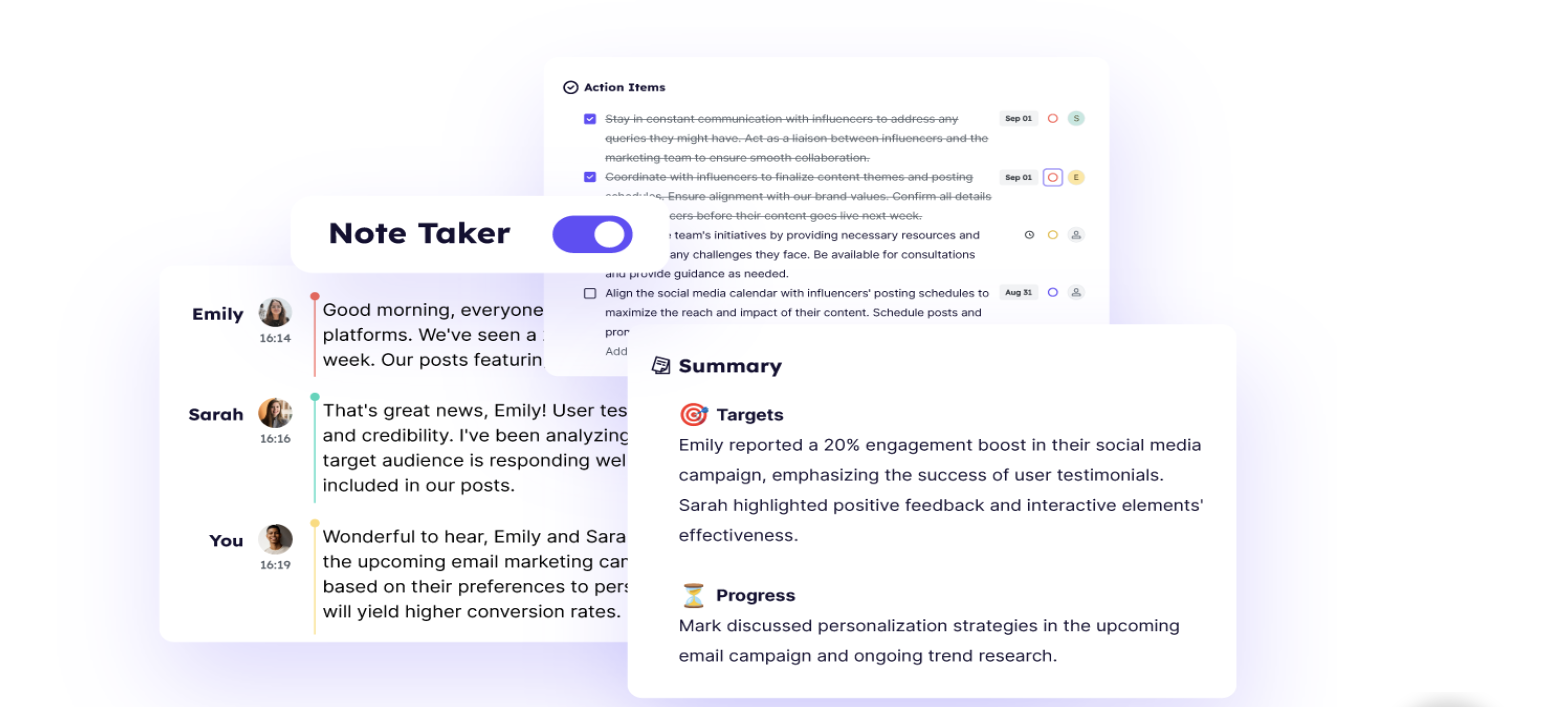A board meeting agenda is a simple but important tool to keep meetings organized and efficient. It outlines the key topics and discussions to be covered, helping everyone stay focused. With a clear agenda, board members know what to expect, can come prepared, and make better decisions.
What Are the Main Components of a Board Meeting Agenda?
A board meeting agenda typically consists of several key components to ensure a structured and productive meeting. Here are the main components, which can be customized depending on the nature of the meeting:
- Call to Order: This marks the formal start of the board meeting, led by the chairperson or president. It signals that the board meeting agenda is officially in effect, allowing the board to begin conducting business. Usually, it includes a brief welcome and a quick review of the board meeting agenda to accommodate any last-minute changes or additions.
- Roll Call or Attendance: During this part of the board meeting agenda, a designated individual, like the secretary, records the presence or absence of each board member. This is important to confirm if there is a quorum—the minimum number of members required to make official decisions or take votes. If a quorum isn’t met, the meeting can continue informally, but no binding decisions can be made.
- Approval of Previous Meeting Minutes: In this part of the board meeting agenda, the minutes from the last meeting are reviewed. Board members can suggest corrections or clarifications. Once approved, the minutes serve as the official record of the prior meeting’s discussions and decisions, ensuring accurate documentation and accountability for future reference.
- Reports:

-
- Financial Reports: The treasurer or finance officer usually provides an update on the organization’s financial health, including income, expenses, and balance sheets. This helps board members understand the current financial situation and make informed decisions.
- Committee Reports: If the organization has standing or ad-hoc committees (e.g., finance, governance, fundraising), those committees present their findings, updates, or recommendations.
- Executive Director or CEO’s Report: The executive team may provide a comprehensive update on organizational operations, strategic initiatives, and any challenges or opportunities.
- Old/Unfinished Business: This section of the board meeting agenda focuses on revisiting topics from previous meetings that were not fully resolved. The board discusses these items to continue conversations, make decisions, or take any required actions to address them.
- New Business: In this part of the board meeting agenda, new items or issues that need the board’s attention are introduced. These could include policy decisions, project proposals, or strategic plans. The board will discuss these matters, and depending on the item, may vote or decide to defer them for future consideration.
- Announcements: Board members or the chairperson share updates on upcoming events, deadlines, or important milestones. It’s also a time to provide information relevant to the organization’s work that doesn’t require board action.
- Adjournment: The board meeting agenda formally concludes with the chairperson leading the adjournment. Any unfinished business can be carried over to the next meeting, and members are informed of the date for the next meeting, if applicable.
This structured agenda ensures that all necessary topics are covered efficiently, and board members can focus on decision-making and strategic planning.
Where Is a Board Meeting Agenda Typically Used?
A board meeting agenda is typically used in various types of organizations and institutions to guide and structure formal meetings. Common settings include:
- Corporate Boards: Used by companies to ensure strategic decisions, financial reports, and operational updates are addressed.
- Nonprofit Organizations: The board meeting agenda helps manage discussions on key areas like fundraising, program updates, and governance. Writing minutes for these meetings involves summarizing discussions, tracking decisions, and documenting actions, ensuring accountability.
- Government Agencies: Used for transparency and accountability in public meetings to address policy issues and public interests.
- Educational Institutions: Boards of trustees or school boards use agendas to discuss academic strategies, budgets, and institutional policies.
- Homeowners Associations (HOAs): For discussing community regulations, budgets, and neighborhood issues.
Why Is a Board Meeting Agenda Important?
Without a well-structured board meeting agenda, businesses risk falling into inefficiency. Meetings might drift off-topic, with important issues overlooked or forgotten entirely. Decisions could be delayed as discussions meander without focus, wasting valuable time. Board members might struggle to stay aligned on priorities, leading to missed opportunities and unresolved conflicts. Old businesses could pile up without proper follow-up, and new proposals may not get the attention they need. So, here’s why having a well-planned agenda is important:
1. Keeps the meeting organized
A meeting agenda helps keep everything on track. Without it, discussions can go all over the place, and important topics might be missed. The agenda ensures everyone knows what’s coming up and can prepare in advance, making meetings run more smoothly. Plus, with tools like Krisp, which is the world’s only bot-free meeting minutes app, staying organized becomes even easier. By cutting out background noise and distractions, Krisp makes sure that conversations are clear, and note-takers can focus on capturing the key points without interruption. It’s a great way to make sure meetings are not only structured but distraction-free too.
2. Maximizes productivity
An agenda makes sure the most important stuff gets addressed first. It prioritizes big decisions and gives a clear timeline, preventing meetings from dragging on or getting stuck on minor details. This way, everyone’s focused on what matters most. Here, it helps everyone stay focused, and since it creates notes after the meeting ends, there’s no need to worry about missing anything important. Krisp helps keep the meeting efficient from start to finish.
3. Improves decision-making
When there’s an agenda, board members come prepared. They know what’s on the table and have had time to gather their thoughts and info. This leads to smarter, quicker decisions because everyone is informed and ready to discuss the key points.
And since Krisp takes meeting minutes, all important decisions and action items are captured right after the call ends. It’s like having an extra layer of clarity to make sure the board makes well-informed choices.
4. Ensures accountability
An agenda helps track old and new business, so nothing falls through the cracks. It keeps everyone on top of what’s been decided and who’s responsible for following up on tasks. This way, the board can hold members accountable for their commitments. Krisp accurately captures who’s responsible for what, making sure everyone knows what they need to do next. Plus, the clear documentation makes it easier to follow up on those tasks later. No one can say they missed something!
5. Saves time
Agendas save time by keeping the meeting focused and preventing side conversations from taking over. It lays out what needs to be covered and assigns time limits, so everyone can get through the meeting without wasting time on less important stuff. Everything can be recorded and ready to review right after the meeting, which means more time spent discussing important things and less time scribbling notes.
Final Thoughts on a Board Meeting Agenda
A board meeting agenda is a simple but powerful tool for keeping meetings organized and efficient. It lays out the key topics and discussions, making sure everything important gets covered while keeping everyone on track. A solid agenda means board members can come prepared, leading to more productive conversations and better decisions. It also helps track old and new business, making it easy to stay accountable and saves time by preventing meetings from going off-topic. Whether it’s a corporate board, nonprofit, or government agency, having a clear agenda is key to keeping things running smoothly and making smart decisions. And with tools like Krisp, which cuts out distractions and provides meeting minutes, the whole process becomes even more streamlined. Together, a good agenda and the right tools make sure meetings stay focused, efficient, and productive—so nothing important gets missed.
Related Resources
Nonprofit Board Meeting Agenda Template: How to Create?
Free Board Meeting Minutes Template: Best Practices
How to Write Minutes for a Nonprofit Board Meeting?
Step-by-Step Guide to Successfully Conducting a Board Meeting
FAQ
– Call to Order
– Roll Call/Attendance
– Approval of Previous Minutes
– Reports
– Old Business
– New Business
– Announcements
– Adjournment
Using Krisp ensures clear, noise-free discussions and real-time meeting minutes for seamless follow-up.
– Purpose: Why the meeting is being held.
– Participants: Who is attending.
– Process: The structure of the meeting.
– Product: Expected outcomes or decisions
With Krisp, meetings stay focused, and clear minutes are captured in real-time.




